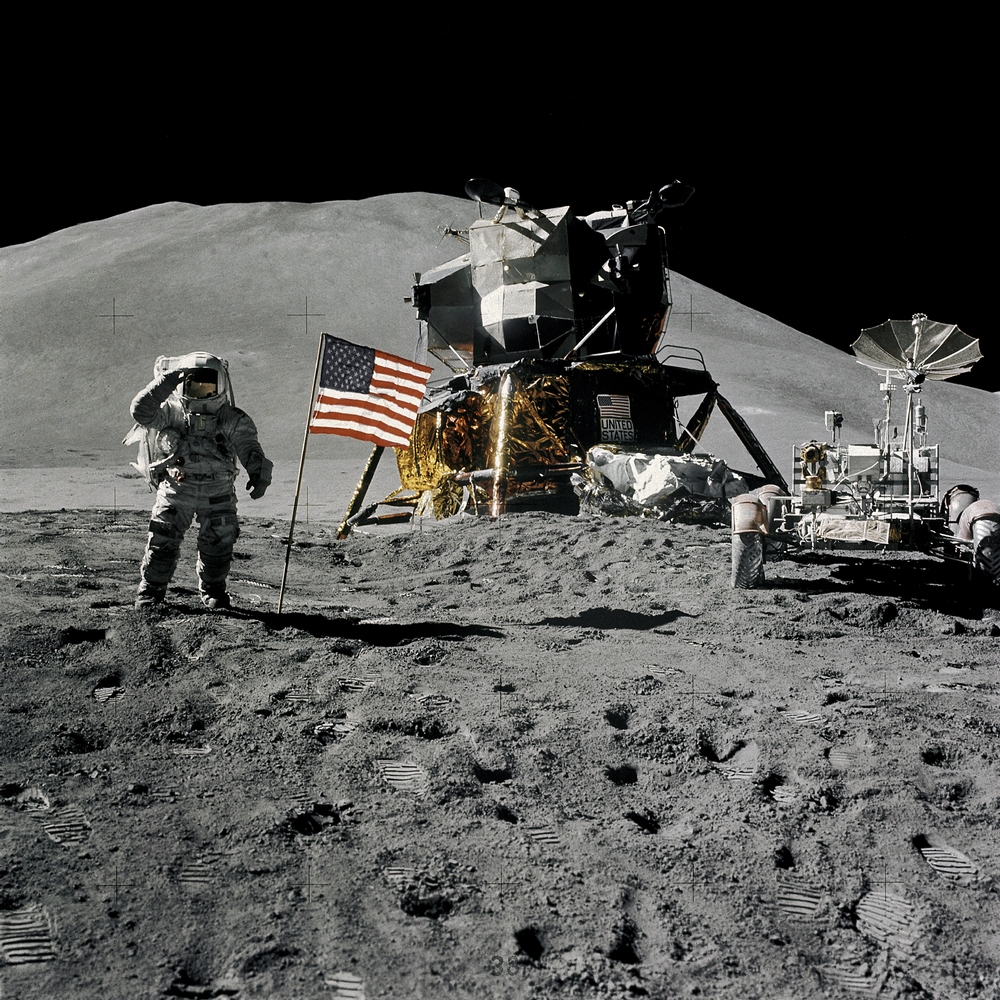
Mar 09, 2016
By Jennifer Levasseur
On February 26, 2016, we opened our latest exhibition of imagery, A New Moon Rises, in our Art Gallery. These stunning images of our largest satellite show, with amazing clarity, our nearest planetary neighbor. But not nearly as clearly as the Apollo astronauts saw it. Here is my top ten list of the most amazing images brought to us by the only 12 people to see the Moon while standing on it. I was not alive for the Moon landings, but these are the images that tell me the story of six missions that changed my world.
Apollo 12 astronauts Conrad and Bean landed close enough to Surveyor III to take this photo.
This image speaks volumes for the fulfillment of a goal. That Apollo 12 astronauts Conrad and Bean landed close enough to Surveyor III to take this photo is truly stunning.
Geologist-Astronaut Harrison Schmitt, Apollo 17 Lunar Module pilot, is photographed next to the American Flag during extravehicular activity (EVA) of NASA's final lunar landing mission in the Apollo series. The photo was taken at the Taurus-Littrow landing site. The highest part of the flag appears to point toward our planet earth in the distant background.
Astronauts on the Moon were really far from home, expressed with this single image of Jack Schmitt from Apollo 17.
Landing on the Moon was, to many, the greatest human achievement yet, and this image of Buzz Aldrin from Apollo 11 cemented that idea in public memory.
When faced with a broken fender on their rover, Cernan and Schmitt worked with help from 386,243 kilometers (240,000 miles) away to fashion a solution that would keep their travels less messy.
Apollo 16 carried the first telescope that operated on another planetary body. The final three Apollo missions in particular were about gathering loads of scientific information for decades worth of research.
In this image from the Apollo 17 mission, the Lunar Rover can be seen in the distance. Look closely and you’ll see the effect of the steep grade on the front right tire of the rover.
That’s a really big boulder and a really small rover next to it. Look closely and you’ll see the effect of the steep grade on the front right tire of the rover during the Apollo 17 mission. Astronauts explored a very challenging environment. 
Not only is there a striking contrast in colors in this photograph of Jim Irwin from Apollo 15, but the contrast between human, technology, and the lunar landscape is intense. 
Landing a lunar module on the Moon wasn’t easy, and this shows the force of impact of just one of the four lander legs on Apollo 14.
Colors on the Moon are far more than the gray/silver we see from Earth. Samples and images from Apollo 17 show the diversity of colors on the Moon, including orange, brown, tan, gray-purple, and blue-gray.
The accomplishments of the Apollo 11 crew and the five crews that landed after them are evidenced by the scientific, engineering, and photographic yield, which are still studied today. What they left behind on the Moon remains a landmark of a unique period in human history.

We rely on the generous support of donors, sponsors, members, and other benefactors to share the history and impact of aviation and spaceflight, educate the public, and inspire future generations. With your help, we can continue to preserve and safeguard the world’s most comprehensive collection of artifacts representing the great achievements of flight and space exploration.
We rely on the generous support of donors, sponsors, members, and other benefactors to share the history and impact of aviation and spaceflight, educate the public, and inspire future generations. With your help, we can continue to preserve and safeguard the world’s most comprehensive collection of artifacts representing the great achievements of flight and space exploration.